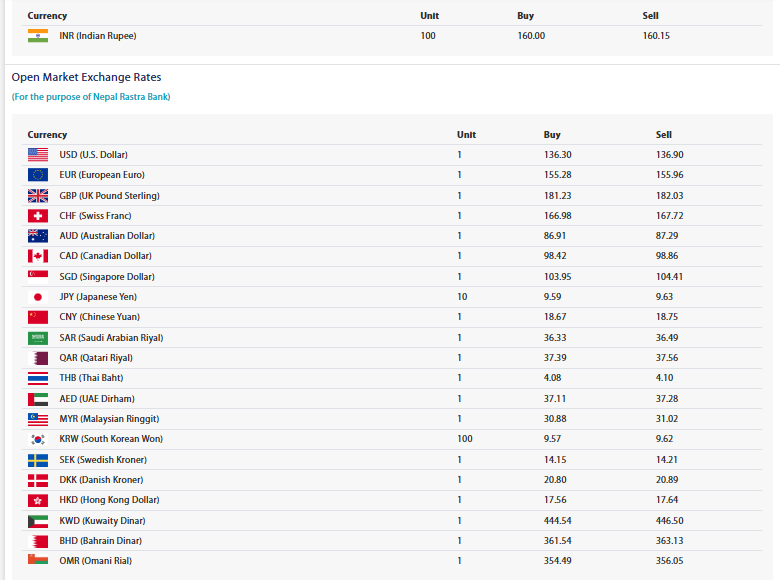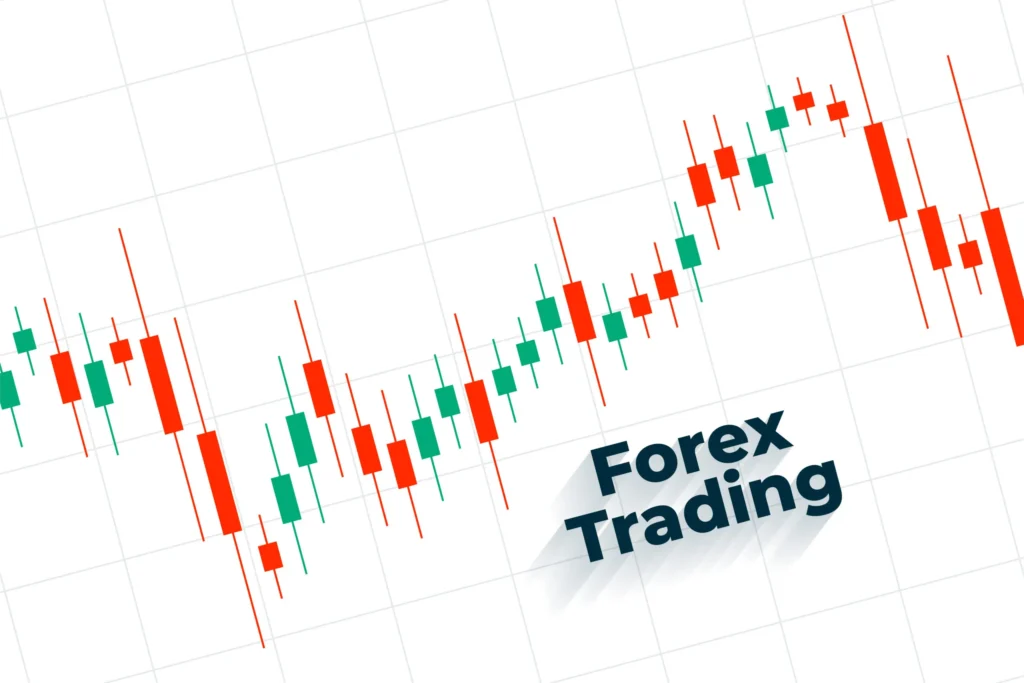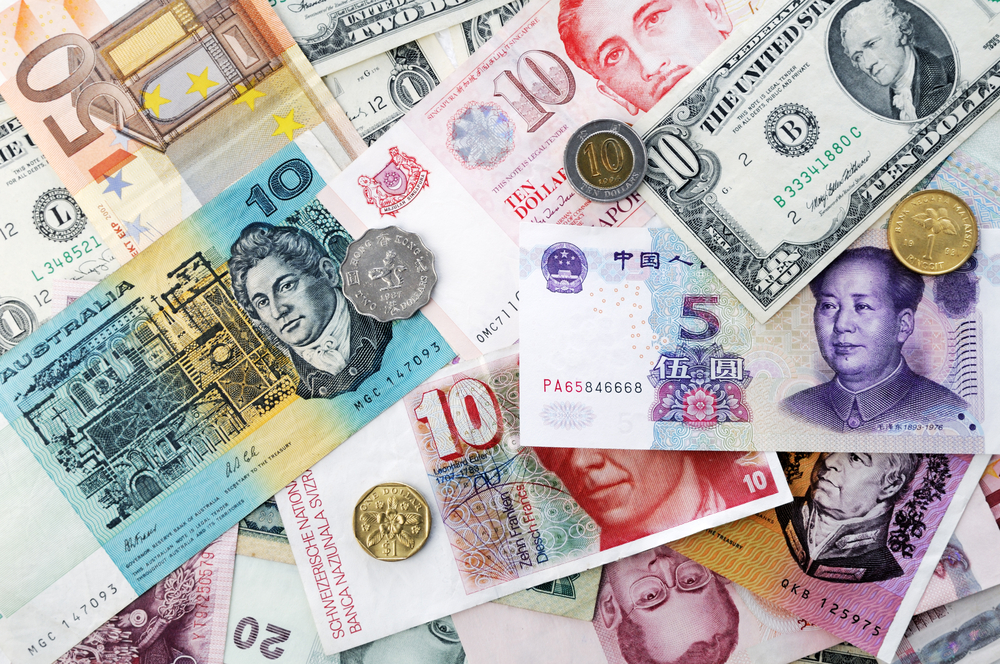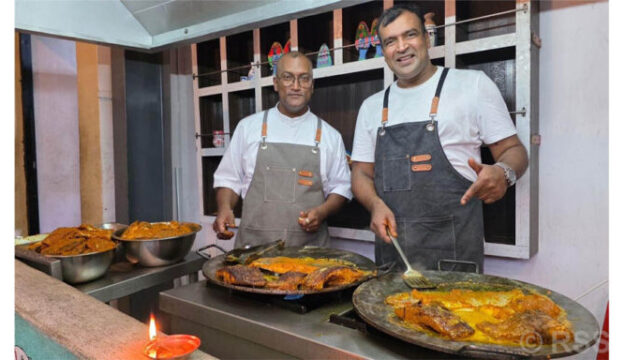The Nepal Rastra Bank (NRB) has published the latest open market exchange rates for foreign currencies, effective for today. According to the central bank, the value of the U.S. Dollar has slightly increased, while the Indian Rupee remains stable against the Nepalese Rupee. These rates serve as an official reference for banks, financial institutions, traders, and the general public for international transactions and remittances.
The Indian Rupee (INR), which shares a close economic and financial relationship with the Nepalese Rupee, remains pegged by policy. The open market rate has been maintained at Rs. 160.00 for buying and Rs. 160.15 for selling of 100 INR. This stable rate helps in ensuring smooth cross-border trade and remittance flow between Nepal and India, Nepal’s largest trading partner.
Among other key currencies, the U.S. Dollar (USD) has been fixed at Rs. 136.30 for buying and Rs. 136.90 for selling. This moderate uptick reflects global currency trends where the dollar has been gaining strength against major currencies due to monetary tightening and inflation concerns in the United States.
The Euro (EUR), one of the most widely used global currencies, is trading at Rs. 155.28 (buying) and Rs. 155.96 (selling). Meanwhile, the British Pound Sterling (GBP), known for its relatively higher value, stands at Rs. 181.23 for buying and Rs. 182.03 for selling, continuing to maintain a strong position in Nepal’s foreign exchange market.

The Swiss Franc (CHF) also posted competitive rates at Rs. 166.98 for buying and Rs. 167.72 for selling. The Franc remains a preferred reserve currency globally due to Switzerland’s political neutrality and stable economy.
Similarly, the Australian Dollar (AUD) and Canadian Dollar (CAD), currencies of two major economies and popular destinations for Nepali migrants and students, are being exchanged at Rs. 86.91 (buying) and Rs. 87.29 (selling) for AUD, and Rs. 98.42 (buying) and Rs. 98.86 (selling) for CAD. The modest fluctuation in these currencies often influences remittance inflows from the Nepali diaspora residing in Australia and Canada.
Asian currencies also play an essential role in Nepal’s foreign exchange scenario. The Chinese Yuan (CNY) is listed at Rs. 18.67 (buying) and Rs. 18.75 (selling), while the Japanese Yen (JPY), measured per 10 units, is valued at Rs. 9.59 and Rs. 9.63 for buying and selling, respectively. China and Japan are two major development partners of Nepal, and their currency trends are closely monitored.
The South Korean Won (KRW), exchanged in units of 100, stands at Rs. 9.57 (buying) and Rs. 9.62 (selling). With a significant number of Nepali workers in South Korea under the Employment Permit System (EPS), the won plays a key role in daily remittance transactions.

The Singapore Dollar (SGD) is currently priced at Rs. 103.95 (buying) and Rs. 104.41 (selling), reflecting its stable performance in the Southeast Asian region. Meanwhile, the Malaysian Ringgit (MYR) is being traded at Rs. 30.88 (buying) and Rs. 31.02 (selling). These rates are crucial for Nepalese workers based in Singapore and Malaysia, where a large portion of the migrant workforce resides.
From the Middle East, where millions of Nepalis are employed, several currencies also show strong exchange values. The Saudi Arabian Riyal (SAR) stands at Rs. 36.33 (buying) and Rs. 36.49 (selling), while the Qatari Riyal (QAR) is listed at Rs. 37.39 and Rs. 37.56. The UAE Dirham (AED) follows closely at Rs. 37.11 (buying) and Rs. 37.28 (selling). These currencies are critical for Nepal’s remittance economy, which forms a substantial part of the country’s GDP.
High-value Gulf currencies such as the Kuwaiti Dinar (KWD) and Bahraini Dinar (BHD) are listed at Rs. 444.54 (buying) and Rs. 446.50 (selling) for KWD, and Rs. 361.54 (buying) and Rs. 363.13 (selling) for BHD, respectively. The Omani Rial (OMR) is exchanged at Rs. 354.49 and Rs. 356.05 for buying and selling. These high exchange rates highlight the strength of Gulf economies and their impact on Nepal’s foreign exchange reserves.
Additional currencies like the Thai Baht (THB) are valued at Rs. 4.08 (buying) and Rs. 4.10 (selling), while the Swedish Kroner (SEK) and Danish Kroner (DKK) are placed at Rs. 14.15 and Rs. 14.21, and Rs. 20.80 and Rs. 20.89, respectively. The Hong Kong Dollar (HKD) is set at Rs. 17.56 (buying) and Rs. 17.64 (selling).

Implications for Traders, Migrants, and the General Public
The daily exchange rates provided by Nepal Rastra Bank serve as a vital guide for currency exchange institutions, travelers, importers, and exporters. Given Nepal’s dependence on remittances, the minor fluctuations in global currency rates have direct implications on household incomes across the country.
For importers, particularly in industries dealing with fuel, electronics, or raw materials priced in USD, even small shifts in dollar value can significantly affect costs. Similarly, for families receiving remittances from abroad, exchange rate movements can change the value of money received in Nepalese Rupees.
Nepal Rastra Bank continues to monitor global market trends and aligns its open market rates based on international currency movements, demand-supply mechanisms, and national monetary policies. By ensuring regular publication of accurate exchange rates, the central bank aims to provide transparency and consistency in the foreign exchange sector.
As currency values remain subject to change depending on geopolitical events, interest rate shifts, and global market dynamics, the general public is advised to stay updated with official rates through authorized sources like the Nepal Rastra Bank website or verified financial institutions.






